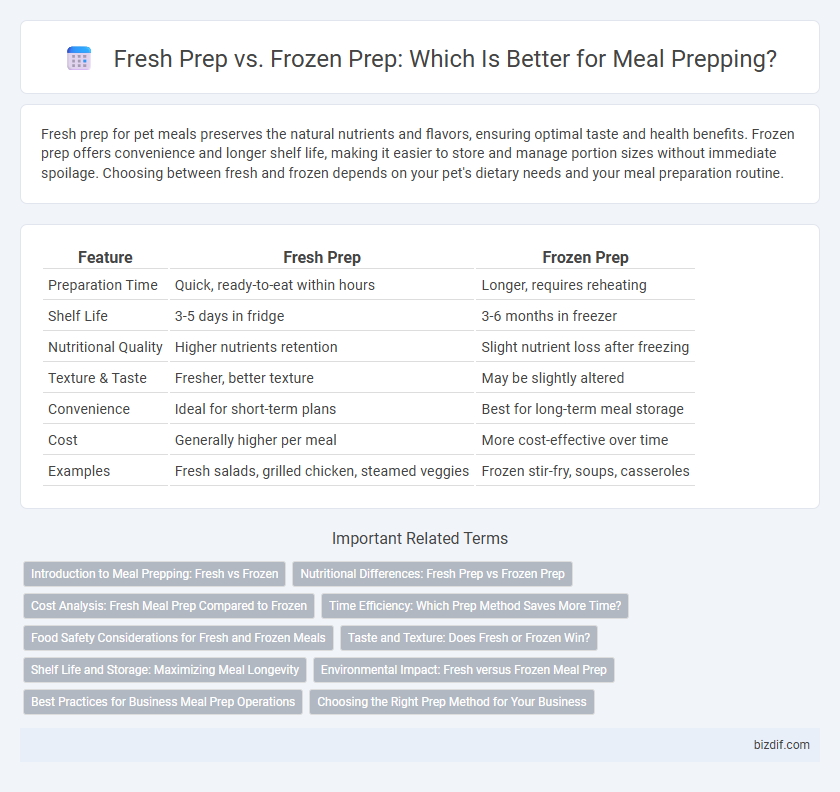Fresh prep for pet meals preserves the natural nutrients and flavors, ensuring optimal taste and health benefits. Frozen prep offers convenience and longer shelf life, making it easier to store and manage portion sizes without immediate spoilage. Choosing between fresh and frozen depends on your pet's dietary needs and your meal preparation routine.
Table of Comparison
| Feature | Fresh Prep | Frozen Prep |
|---|---|---|
| Preparation Time | Quick, ready-to-eat within hours | Longer, requires reheating |
| Shelf Life | 3-5 days in fridge | 3-6 months in freezer |
| Nutritional Quality | Higher nutrients retention | Slight nutrient loss after freezing |
| Texture & Taste | Fresher, better texture | May be slightly altered |
| Convenience | Ideal for short-term plans | Best for long-term meal storage |
| Cost | Generally higher per meal | More cost-effective over time |
| Examples | Fresh salads, grilled chicken, steamed veggies | Frozen stir-fry, soups, casseroles |
Introduction to Meal Prepping: Fresh vs Frozen
Meal prepping involves preparing meals in advance, offering the choice between fresh and frozen options to suit different lifestyles and nutritional needs. Fresh prep emphasizes immediate consumption of nutrient-rich, unprocessed ingredients, preserving taste and texture, while frozen prep extends shelf life, providing convenience and reducing food waste. Selecting between fresh and frozen meal prep depends on factors such as time availability, dietary preferences, and storage capabilities.
Nutritional Differences: Fresh Prep vs Frozen Prep
Fresh meal prep retains higher levels of heat-sensitive nutrients like vitamin C and certain B vitamins compared to frozen prep, as freezing can cause nutrient degradation over time. However, frozen prep preserves minerals and macronutrients effectively, making it a convenient option without significant loss in overall nutritional value. Understanding these differences helps optimize meal planning for nutrient retention and dietary goals.
Cost Analysis: Fresh Meal Prep Compared to Frozen
Fresh meal prep typically involves higher upfront costs due to purchasing fresh ingredients weekly, which can vary by season and availability, leading to greater expense compared to frozen meal prep. Frozen meal prep benefits from economies of scale and bulk purchasing, reducing per-meal cost and minimizing food waste with extended shelf life, making it a budget-friendly option. Cost analysis often shows frozen meals save approximately 20-30% compared to fresh meal prep, especially when factoring in storage and preparation time efficiency.
Time Efficiency: Which Prep Method Saves More Time?
Fresh prep typically requires more time upfront due to washing, chopping, and immediate cooking, while frozen prep offers significant time savings by allowing bulk cooking and storage for quick reheating. Frozen prep reduces daily meal preparation to simple reheating steps, enhancing convenience and efficiency for busy schedules. Studies show frozen meal prepping can save up to 50% more time during the week compared to fresh meal preparation.
Food Safety Considerations for Fresh and Frozen Meals
Fresh meal prep requires strict temperature control and prompt refrigeration to prevent bacterial growth, while frozen prep relies on maintaining consistent freezing temperatures below 0degF to preserve food safety. Cross-contamination risks increase with fresh ingredients if not handled properly, whereas frozen meals benefit from reduced microbial activity during storage but must be thawed safely to avoid pathogen development. Both methods demand vigilant hygiene practices and proper storage timelines to ensure meals remain safe for consumption.
Taste and Texture: Does Fresh or Frozen Win?
Fresh meal prep preserves natural flavors and maintains crisp textures, offering a more vibrant and satisfying eating experience. Frozen meal prep can slightly alter texture, often softening vegetables and proteins, but retains nutritional value well when flash-frozen promptly. For optimal taste and texture, fresh prep typically outperforms frozen, especially for dishes relying on crunch or delicate flavors.
Shelf Life and Storage: Maximizing Meal Longevity
Fresh prep meals typically last 3 to 5 days in the refrigerator, making them ideal for short-term consumption, while frozen prep meals can maintain quality for up to 3 months or more when stored properly in airtight containers. Optimal storage for fresh prepped ingredients involves airtight containers and consistent refrigeration at or below 40degF (4degC), whereas frozen preps require stable freezing at 0degF (-18degC) to prevent freezer burn and nutrient loss. Prioritizing proper packaging and temperature control maximizes the shelf life and helps retain flavor, texture, and nutritional value in both fresh and frozen meal preps.
Environmental Impact: Fresh versus Frozen Meal Prep
Fresh meal prep typically has a lower carbon footprint due to reduced energy consumption during storage and transportation compared to frozen meals. Frozen meal prep requires continuous freezing and freezing infrastructure, which increases greenhouse gas emissions. Choosing fresh ingredients sourced locally can significantly reduce environmental impact by minimizing transportation distances and reliance on energy-intensive preservation methods.
Best Practices for Business Meal Prep Operations
Fresh prep maintains optimal ingredient quality and flavor by using seasonal, locally sourced produce, which enhances customer satisfaction and supports sustainability goals. Frozen prep ensures consistent inventory management and reduces food waste through extended shelf life, making it ideal for scaling operations and handling peak demand periods efficiently. Combining batch cooking techniques with precise temperature control and strict hygiene protocols optimizes safety and operational efficiency in business meal prep environments.
Choosing the Right Prep Method for Your Business
Selecting the appropriate prep method hinges on your business's operational needs, target clientele, and storage capabilities; fresh prep offers superior taste and nutrient retention, ideal for local delivery and same-day consumption. Frozen prep extends shelf life and enables bulk production, reducing food waste and expanding distribution range to accommodate larger markets. Evaluating factors such as supply chain logistics, equipment investment, and customer demand ensures optimal balance between freshness, cost efficiency, and scalability.
Fresh Prep vs Frozen Prep Infographic

 bizdif.com
bizdif.com